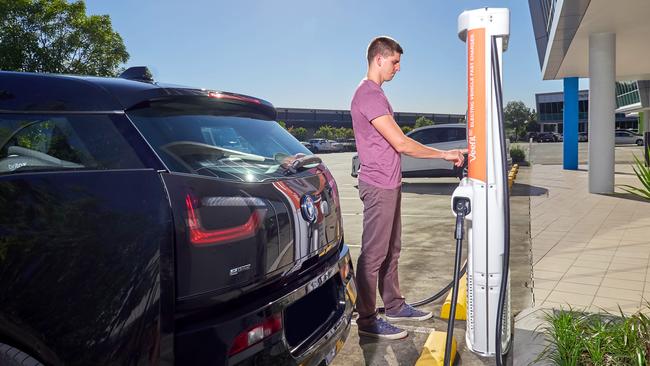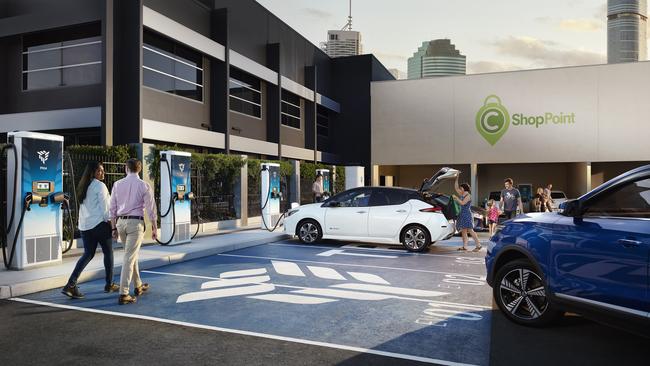Queensland to experience rapid growth in electric vehicle use
There are two factors driving the increase in EVs in Queensland, which is tipped to have 800,000 electric vehicles on the road in just a decade.
QWeekend
Don't miss out on the headlines from QWeekend. Followed categories will be added to My News.
Queensland may have been a little slow off the mark with the adoption of electric vehicles, but there’s now a push to let the Sunshine State take charge of the national EV strategy.
The number of electric vehicles on Queensland roads has picked up rapidly, with about
10,000 registered EVs currently in Queensland, double the amount of a year ago.
But this is a mild increase compared to the road ahead, with 800,000 electric vehicles estimated to be running on Queensland roads in 10 years’ time.
Electric vehicle buyers to save thousands through FBT exemption
800,000 electric vehicles tipped to be on Qld roads in next decade
Electric vehicles explained and the eight biggest myths busted
There’s nothing special about Queensland’s expansion in EVs – in fact, Queensland still lags other states and other countries in many ways. But the wide open spaces of Queensland, the most decentralised state in Australia, present different challenges for policymakers.
As RACQ chief executive David Carter puts it: “If the federal government is to lead the nation on a successful transition to electric vehicles, they must let Queensland take the front seat with them.”
“We know there is an overwhelming hesitancy about EVs that persists throughout Queensland, and it grows the further you are from the city. However, there are massive economic opportunities that would benefit the entire state.”
There are two factors driving the increase in EVs in Queensland, one international and one local. The first is the greater range of EVs themselves, with most new electric vehicles now having a range of about 500km, whereas those only a few years old generally have a range of closer to 300km.
This means that a trip from Brisbane to, say, Mackay, only needs two stops for refuelling in a modern EV, while in the past it would have been four or five.
The second big change is a local one – there are a lot more charging stations.

Website Plugshare, which lists every charging station around the world, shows that in Queensland, there are just over 90 sites with a fast charger that can deliver over 50kWs.
But put this in perspective – Norway, which has a similar size, population and geographic dispersion to Queensland, has more than 6700 fast chargers spread over thousands of sites.
Of the current sites in Queensland, nine are run by the Tesla network, while Evie Networks, part of the St Baker Energy Innovation Fund, currently has 14 sites in Queensland, with plans to roll out another 150. But the biggest provider in Queensland isa product of the state government, the Queensland Electric Super Highway, which currently has 31 charging stations operating and another 24 planned over the next few years.
The majority of the new 24 are in rural and regional Queensland, with Kingaroy being the first under construction, then Longreach, Barcaldine, Blackall, Charleville, Miles and Stanthorpe.
Having these stations in place will make it easier to take an EV to western Queensland.
Paul Fox, head of corporate development and co-founder of Evie Networks, Australia’s biggest private supplier of EV charging stations, said the Queensland government was taking early action by setting up the super highway.
“Like electricity, telephones and broadband, it is harder to make the economics work in the bush,” he says. “Therefore there is a definite role for government in ensuring equity for rural Queensland.
“But many of the (super highway) sites have only a single charger, so if it is occupied or broken there is a problem.”
At the moment it is quite easy to move around South East Queensland in an electric vehicle and just as easy to undertake an extended road trip up the coast to Cairns.
Motorist Chris Cathcart has done the trip from Brisbane to Cairns and back twice, most recently earlier this year, and he says there is far more infrastructure in place now than when he first did it in 2018.
“When I first went up, there were gaps of up to 210km between stations, but now, the longest gap is around 140km, and the average distance between stations is 170km,” he says. “And it’s a very easy trip to navigate now, and there’s much better software to show you where the next charging station is.”
But one of the major issues for EV road-trippers is the time it takes to charge up. About 80 per cent of all charging is done at home – Cathcart has a solar-powered charger at home, for example – but obviously on a road trip there needs to be other charging stations.
While many of the charging stations in rural and regional Queensland are beside cafes or parks so motorists can break up their trip, a charge up is rarely less than 20 minutes and can sometimes be up to an hour.
Michael Kane, public policy officer for the RACQ, says that most of the fast-charging sites are single 50kW chargers.
“We need to add more faster 75kW or ultra-fast 250kW-350kW chargers and we need more chargers per site or location as demand increases,” he says.
“We will need continued growth in fast charging infrastructure for at least 10 years as demand for EVs takes off.” He says that one of the best road-trip charging opportunities in Queensland was the Tropical North Queensland EV Drive, running from around Innisfail to the Atherton Tableland and north to the Daintree.
“500km of free charging at pretty amazing tourism locations across the Cairns hinterland,” he enthuses.
Research undertaken by the RACQ shows that another major disincentive to purchasing an EV is the cost, with EVs starting in Australia at around $45,000, and going up to around $200,000.

They contain fewer moving parts than an internal combustion engine and are easy to assemble, which means that in the long run, their cost will come down. But for at least the next few years they will remain more expensive than internal combustion vehicles as car manufacturers want to recoup their research investment sooner rather than later.
Both state and federal governments are paying direct subsidies for people buying an EV.
The Queensland government pays a subsidy of $3000 for any person or company buying an EV, while legislation recently passed through the federal parliament will cut fringe benefits tax on low-emission vehicles which will lead to an average saving of $4700 on a new EV.
But many in the industry are pushing for the federal government to follow the example of many countries overseas and introduce fuel-efficiency standards, which would increase the supply of EVs as they complied with those standards.
Katie Nguyen, a partner in PWC’s Integrated Infrastructure team in Brisbane, says that such standards have been operating in the US, Japan and China for at least the past decade, while the EU has also recently followed suit.
“That’s one of those levers that governments can pull to change the market. Developed countries with those standards in place are not showing any of the constriction in supply that we have in Australia,” she says.
“If we had those standards operating in Australia then that would go a long way between bridging the gap between supply and demand. What other countries have shown is that fuel emission standards can make cars more efficient, increase their range and reduce emissions.”
She says that a greater supply of used cars would help create a second-hand car market, which would also increase the take-up of EVs within the community. And the creation of a second-hand market will be the real signal that electric vehicles are hereto stay.
Having 800,000 EVs on the road in Queensland in a decade will require at least an extra 1600 public charging stations to cope with the expansion.
Policymakers say that getting all the elements in place – an extensive network of public charging stations, fuel-emission standards, tax incentives for EVs – would help create a substantial second-hand market for electric vehicles that were three or four years old and could be purchased for possibly as low as $30,000.
By that stage, the momentum will be there to fully convert all vehicles in Queensland to electric, nonpolluting vehicles.


